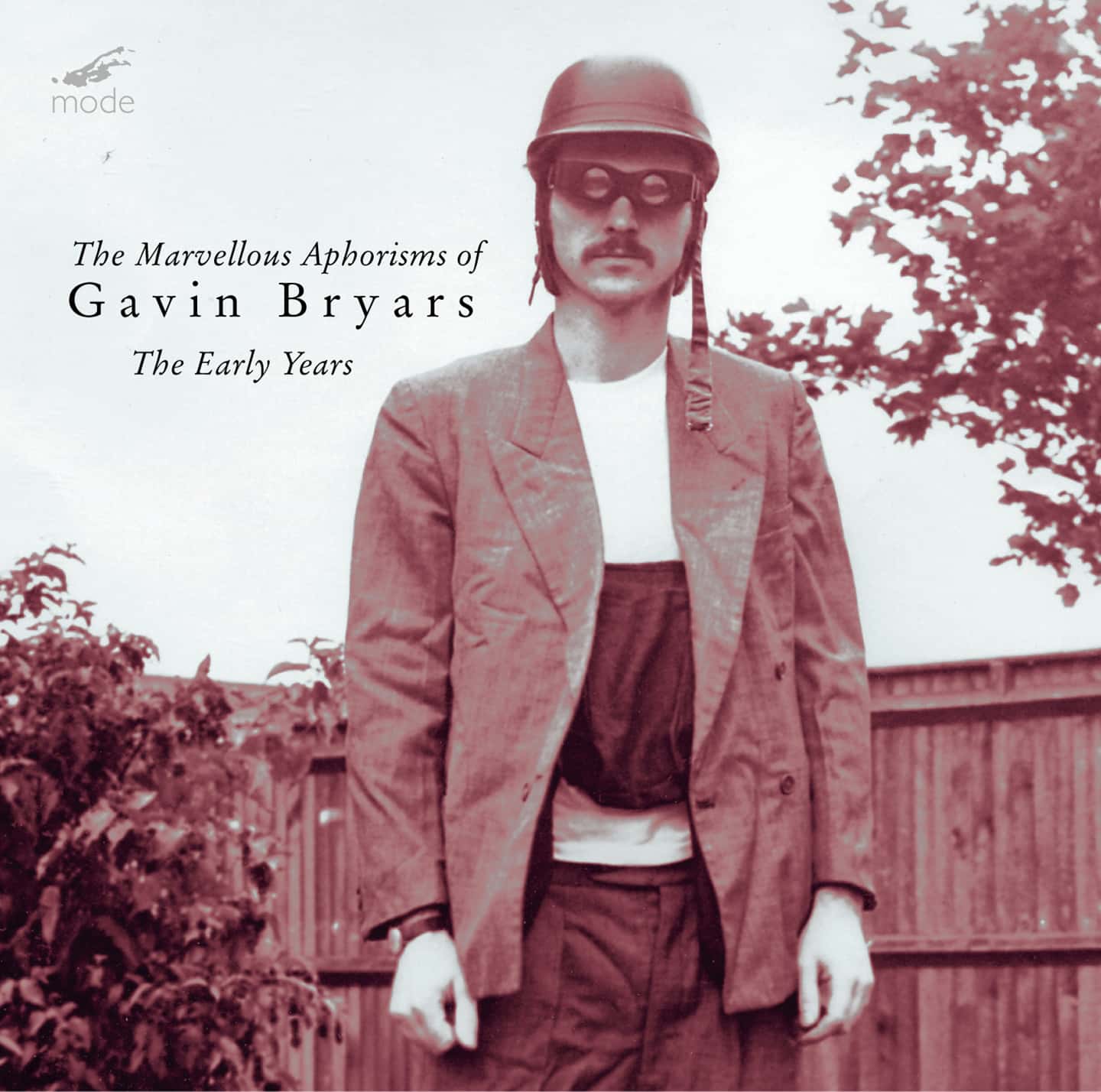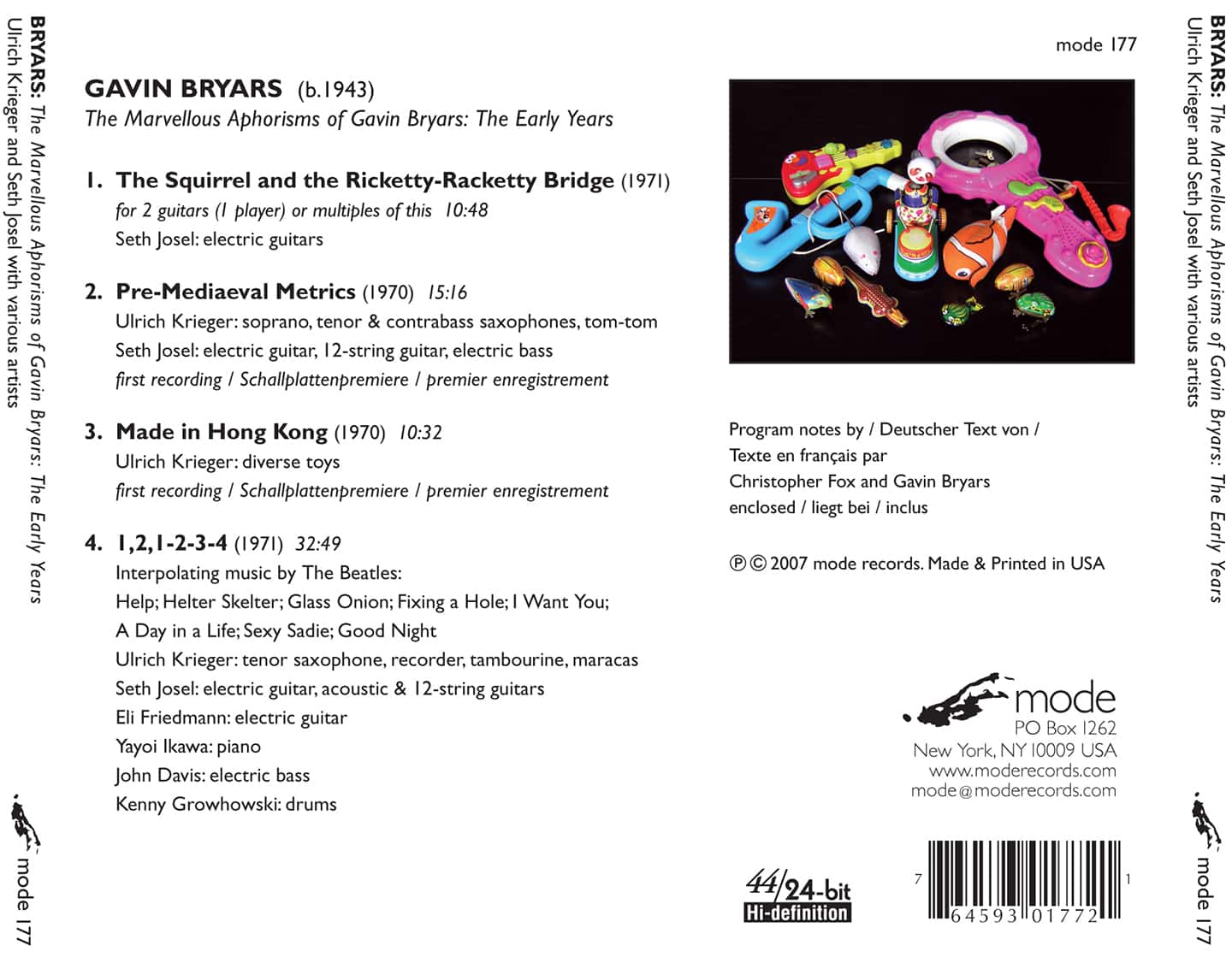The Marvellous Aphorisms Of Gavin Bryars: The Early Years
Includes program notes. Streaming audio. Title from image of compact disc cover on Web page (viewed Nov. 21, 2008) Performed by Seth Josel, Ulrich Krieger, Eli Friedmann, Yayoi Ikawa, John Davis, Kenny Growhowski. Recorded at Trace Elements Records, Melody Lanes and LRP Studios, New York, Feb. and June, 2004. Also available as compact disc; previously issued as Mode Records mode 177.
Pre-Mediaeval Metrics (1970)
Ulrich Kreiger, saxophones
Seth Josel, guitars
FIRST RECORDING
Made in Hong Kong (1970)
Ulrich Kreiger, various toys
FIRST RECORDING
1, 2, 1-2-3-4 (1971)
Ulrich Kreiger, saxophones & percussion
Seth Josel, guitars
Eli Friedmann, electric guitar
Yayoi Ikawa, piano
John Davis, electric bass
Kenny Growhowski, drums
The Squirrel and The Ricketty Racketty Bridge (1971)
Seth Josel, guitars
Gavin Bryars’ music, post “The Sinking of the Titanic” and “Jesus’ Blood…”, is well known and often performed today. Less known are the earlier works featured on this CD, created during the years 1969-71. At that time, Bryars became associated with Michael Nyman, John Tilbury and Brian Eno – marrying ideas from Cage, Fluxus, free improvisation and experimentalism.
Some of the works recorded here appeared on Eno’s avant-garde Obscure label in the mid-1970s.
In 1, 2, 1-2-3-4, the musicians listen to the same music on individual cassette tapes through headphones, playing along with what they hear rather than responding to each other. Bryars was curious about the “new” cassette technology, how the various tape decks would never be properly synced to each other; and so the musicians would drift further apart from each other over the performance’s 30-minute plus duration – with amazing results. The audience hears the collective product of this private listening. In this realization, the performers respond to a collection of songs by The Beatles (Help; Helter Skelter; Glass Onion; Fixing a Hole; I Want You; A Day in a Life; Dear Prudence; and Good Night).
The notation of Pre-Mediaeval Metrics consists of pairs of phrases arranged in four columns on eight pages. Each phrase is made up of four symbols, either dashes (‘an appreciable duration (at least one second)’, instructs the score) or dots (‘as short as possible’). Instrumentation is free but all instruments use only one sound throughout.
Made in Hong Kong is scored for “…toys, mechanically operated, manually operated, toy sustaining instruments and any other considered usable.” Its humorous and cacophonous sound is an homage to the countless toys for children, commonly made at that time in Hong Kong.
The Squirrel and The Ricketty Racketty Bridge was written for guitarist Derek Bailey. The guitarist has to play two guitars simultaneously, placed flat on their backs, using a hammer technique which produces a pair of notes with the side of the finger. One hand plays constant quavers, like a bassist in conventional jazz, with two fingers across pairs of frets while the other plays isolated notes and phrases, like a lazy soloist.
Liner notes by Christopher Fox with Gavin Bryars.
Reviews
Gavin Bryars
The Marvellous Aphorisms of Gavin Bryars: The Early Years
Mode 177
“Gavin Bryars’ earlier works – featured on this CD – were created during the years 1969-71. At that time, Bryars was making compositions featuring ideas from John Cage, Fluxus as well as free improvisation. Some of the works had never been recorded before, like Pre-Mediaeval Metrics, or Made in Hong Kong. In 1-2-1234, the six musicians listen to the same music of the Beatles through headphones playing along with what they hear rather than responding to each other. The audience hears the marvellous collective product of the private listening. A must-have CD for your collection!”
— Abitare magazine (Italy), February 2008
Gavin Bryars
The Marvellous Aphorisms of Gavin Bryars: The Early Years
Mode 177
While Gavin Bryars is best known for his long-form compositions (“The Sinking of the Titanic,” Jesus’ Blood Never Failed Me Yet), he also played a significant role in the early development of British free improv, playing bass in the trio Joseph Holbrooke with Derek Bailey and Tony Oxley. He left the trio, which was far from any level of fame, to focus on composing and on this CD the New York label Mode presents four of those early pieces in updated interpretations.
“The Squirrel and the Ricketty-Racketty Bridge” was written for Bailey, who included it on his 1971 Solo Guitar Volume 1 and also played on a 1978 quartet version with Bryars, Brian Eno and Fred Frith (released on Eno’s Obscure label). The piece calls for at least one guitarist and two guitars and here is performed by New York-born Seth Josel, who now lives in Berlin. The primary difference between his and previous versions is in the electronics; where earlier versions were rough and textural, played on hollow-body instruments, Josel’s electric version is comparatively pristine. While the clean sustain of his guitars brings out the counterpoint of the composition – an ascending and descending 12-note run with hammered, harmonic interruptions – the same quality robs the piece of its meat. The players’ struggles with the instruments and the listeners’ struggles to follow the piece’s logic are lost – which depending on taste might make it more enjoyable or just dumb it down.
“1, 2, 1-2-3-4” was also released in a previous version on Obscure. The piece calls for a group of musicians playing the same set of music, but following different arrangements on headphones, rather than playing “together.” The 1975 version was a sort of slow, plaintive jazz piece, with the differing intervals creating accidental dissonances that may have sounded stranger thirty years ago than they do in the age of sampling and digital music. The growing ambiguity in the work is similar to the hazy approximations of melody Bryars was exploring around the same time with the Portsmouth Sinfonia, a chamber orchestra comprised of people who didn’t know how to play their respective instruments.
For the new version, Josel and saxophonist/session leader Ulrich Krieger, along with piano, bass, drums and a second guitar, use a half-hour Beatles medley as the recorded source. The familiarity of the riffs and the tendency to try to sing along mentally make this an entirely different piece of music. On record it’s a good bit of jumbled fun, but at the ensemble’s Nov. 8, 2007 performance of the same material at New York’s Roulette, it proved to be tough going; watching them perform made it harder to suspend the belief that they should be playing “together,” which may be truer to Bryars’ intentions.
Likewise, watching the performance of “Made in Hong Kong” – a piece scored for mechanical toys – robbed it of the mystery it carries on record. The scattered percussion of hopping toys, paired with electronic beeps and voices, is more successful in the abstract, removed from the visual cues of its sources. The fourth piece of the CD and concert was the most effective: “Pre-Mediaeval Metrics” is a pulse piece based on rhythms in Latin poetry, rendered here by multi-tracked saxophones and guitars. With all the lovely blur and clutter of the other pieces, the fifteen minutes of “Metrics” come off as positively austere.
— Kurt Gottschalk, www.allaboutjazz.com, December 14, 2007
Gavin Bryars
The Marvellous Aphorisms of Gavin Bryars: The Early Years
Mode 177
When listening to the work of British composer Gavin Bryars, it’s tempting to think you’ve awakened on some mirror earth-planet where time and pitch operate in other dimensions.
The 67-year-old composer, who wrote the odd but transfixing “The Sinking of the Titanic,” is well-known for collaborations with the likes of opera director Robert Wilson, choreographer Merce Cunningham and artist Christian Boltanksi. This CD offers Bryars’ early works, from 1970 and 1971, and they are some of his most intriguing compositions.
On “The Squirrel and the Ricketty-Racketty Bridge,” Bryars has written a series of repeating two note intervals for two electric guitars. The music here comes at the listener as a weaving pattern of notes. At times this work recalls the returning arpeggios of Philip Glass, at others the repetitions form a larger pattern that gives the music its unique shape. But that pattern is one that can only be gleaned if heard all the way through.
By far, the best track on this CD, for the way its sound seems to bend out of a black musical hole, is “Made in Hong Kong.” This 10-minute exploration has Bryars calling for the use of sound making toys like rattlers, robots, toy trains and jack-in-the-boxes. Listening to this mesmerizing clockwork arrangement of overlapping sounds is much like sitting in on a petite symphony whose music is filled with a David Lynch-like sense of color, mystery and malevolence.
In “1-2, 1-2-3-4” Bryars takes a medley of Beatles songs, including “Helter Skelter,” “A Day in the Life,” and “Fixing A Hole” and reconstructs them by varying tempos played on piano, electric guitar, bass, drums, saxophone and other instruments. Here the music recalls the wit and experimentation of John Zorn, except this music owns a strange world-weariness.
Less fetching is “Pre-Mediaeval Metrics,” a vapid 15-minute amalgam of struck chords for saxophone, tom-tom, electric bass and 12-string guitar.
It’s amazing how cutting-edge this music still sounds now, even after 30 years. Perhaps this is the greatest charm of this CD, which is highly recommended for those with a musical adventurous streak or fans of the experimental.
— Edward Ortiz, The Sacramento Bee (California), November 2007
Gavin Bryars
The Marvellous Aphorisms of Gavin Bryars: The Early Years
Mode 177
Op de sepiakleurige cd-hoes staat een man in de tuin de lens in te loeren: Willempie-helm op, snorretje, vliegeniersbril, verkreukeld jasje met daaronder half verborgen een tas. De man met de helm is componist. En niet zo maar een, maar Gavin Bryars. De verwantschap die Bryars (1943) voelt met de lijfelijkheid van popmuziek, is duidelijk af te lezen in zijn levensloop. Zo was de Engelse componist in zijn studentenjaren werkzaam als jazzbassist en gold hij als pionier op het gebied van de vrije improvisatie. In het begin van de jaren zeventig speelde hij in het ensemble van Steve Reich en in het Scratch Orchestra van Cornelius Cardew; om ten slotte in de jaren negentig het ‘Jesus’ Blood’ te maken, een smartlap die zelfs door Tom Waits werd gecoverd. Op deze cd niet de zoetgevooisde Bryars, maar de vroege, experimentele componist. In ‘1,2,1-2-3-4’ luisteren de spelers individueel over de koptelefoon naar een cassettebandje (modern!) met popnummers, en proberen daarmee mee te spelen. Gevolg: een meerstemmigheid aan Beatles-liedjes die buitengewoon verfrissend klinkt. Heel actueel klinkt ‘Pre-Mediaeval Metrics’, een werk waarin de computer (ook modern in 1970) een reeks streepjes en puntjes heeft uitgespuugd op papier, die de spelers ritmisch moeten interpreteren. Alles zeer consciëntieus gespeeld door onder meer Ulrich Krieger (slagwerk) en Seth Josel (elektrisch gitaar).
— Anthony Fiumara, Trouw, zaterdag 27 oktober 2007


